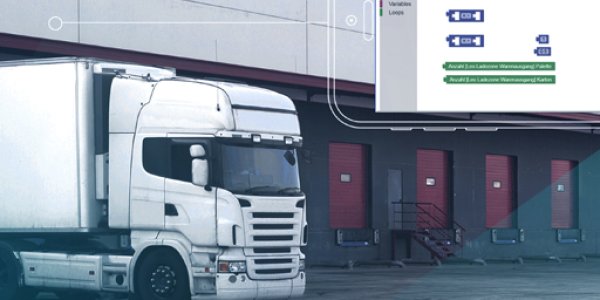The age of digitalization has brought about striking changes for the world of communication, both in the private sphere and in business: communication is becoming more digital, more efficient, more individual, more global and, above all, more hybrid: it is becoming apparent that there is no one communication channel, but that more and more different services are being used simultaneously. What has already been normal for several years in the private sector through WhatsApp and Co. is increasingly establishing itself in the business world with tools such as MS Teams or Slack. But what does all this mean for transport and site logistics?
The change in communication opens up opportunities to rethink collaboration in the business world and, in particular, to digitalize collaborative processes. Artificial intelligence will be another gamechanger here, giving structural change a further boost.
Hardly any other logistics discipline involves as much division of labor as transport and site logistics
In transport and site logistics, many process steps are carried out by different participants in different organizations with different systems. It sounds supposedly simple: a transport of purchased or sold goods to the recipient of the goods via direct truck transport. But even this simple example involves a number of process participants, both inbound and outbound:

Based on the figures, it can be seen that even a simple direct truck transport in both directions involves up to ten or more parties in the process. This is to be considered cross-organizational, which means that different systems are usually in use.
It becomes even more complex when intermodal transports are involved, especially when, for reasons of optimization potential, the individual transport sections are organized in-house. In order to handle all these transports on schedule, but also efficiently in terms of costs, CO2 and capacity utilization, a high degree of coordination and a continuous flow of information between all those involved is required. After all, communication is what makes or breaks any relationship. This is true not only in the private sphere, but also in the corporate environment.
The challenges of our customers
As part of our service, the so-called "journey planning", I was able to accompany a large number of companies in the past year in their transformation moving away from transport management to active transport control. In a nutshell, the first step in our journey planning is to discuss challenges with the systems currently in use, then to derive strategic goals and define guidelines, analyze the as-is processes and jointly transfer them into to-be process models.
On this basis, a highly integrative solution design is developed, topic clusters are jointly prioritized according to added value and strategic importance, and expansion stages are deduced from this. The result of the journey planning is a clear roadmap of what is necessary from a technical and process perspective to successfully close any digital gaps so that the companies' goals in transportation and site logistics are achieved. Another result is the identification of the necessary preliminary work as well as project planning and cost overview.
When elaborating on our customers' challenges, there is a consistent picture across industries. These are the top 6 challenges and goals mentioned:
- Challenge: different applications in transportation and site logistics from different vendors, resulting in process gaps that disrupt the flow of information. Likewise, manual work and duplicate maintenance are commonplace
Goal: a fully integrated system network that maps both planning and operational processes and ensures a continuous flow of process information - Challenge: intransparency along the process chain - transparency is only possible through tedious compilation of information and manual rework, but usually too late
Goal: a platform with a leading logistics document that bundles all information flows of the different process participants and systems, evaluates them intelligently and distributes them accordingly via hybrid communication channels; no media discontinuity - Challenge: Black box in inbound - the order including the desired delivery date is transmitted to the supplier via EDI, mail and very often fax. Often, communication ends here until the truck arrives. But what was really loaded is a surprise and only transparent at the gate. In some cases there is an order confirmation
Goal: uniform notification of suppliers at item level and creation of partial deliveries in the system, including notification functions. There is also a trend for inbound logistics to be increasingly organized by the consignee himself, in order to achieve bundling potential and thus cost-saving and sustainability goals. This requires a "ready for pickup" approach. This also leads to the integration of subsequent processes such as planning, commissioning, appointment scheduling, track & trace, yard management and collaborative freight cost management. - Challenge: complex service provider integration with 1:1 connections via EDI, FTP or even commissioning via e-mail.
Goal: digital commissioning of service providers, order-as-a-service approach, managed by SaaS provider. - Challenge: customers are not proactively informed of changes, customer service is reactive to customer demand.
Goal: early proactive and automated notifications, on the channel of the customer's choice - Challenge: Site logistics is decoupled from transport logistics, in terms of systems, but more importantly, in terms of organization. Likewise, long lead times and congestion at the entrance are the norm
Goal: fast, efficient and contactless processing on the site of the plant. Dynamic appointment scheduling and door assignment based on inflow information, as well as the organizational change to a uniform logistical discipline.
What logistical challenges mean in terms of communication
For the field of communication among supply chain participants, the requirements mentioned by our customers mean that, in addition to classic logistics systems, collaborative options in particular must be able to be used dynamically, and the change is already in full swing.
Using the example of inbound, this has often meant that, for example, the order is transferred from an ERP system to the supplier, but the supplier does not want to log on to any web portal. With regard to hybrid communication, the scenario arises that the order is transmitted directly via API and the customer service employee confirms the order via Slack message on the way to the coffee machine. The notification at item level is again only carried out later from the ERP system, so that the information about quantities and date for collection is again transmitted via API. The goods recipient again orders the freight forwarder right from the system. For a small forwarder, this can be done via automated email, web UI, or even an MS Teams message, for example. For larger carriers, on the other hand, API communication is usually preferred.
The truck drivers communicate via WhatsApp until they arrive at the plant site and receive a link for a Progressive Web App during contactless check-in via terminal. Further communication, such as retrieval, navigation through the site, and any checks and images, are done via the app. The information about the delivery to the shipper, in turn, comes directly from the truck's telematics.
This example already shows that in the future it will be necessary to integrate different technologies in order to make the flow of information not only consistent, but also as efficient as possible and, above all, target group-oriented. In the Asian region in particular, communication or even payment using the chat service WeChat has long been established in logistics. This requirement is also regularly mentioned by our customers as part of our travel planning.
Demographic change also plays a major role here. Generation Y and soon Generation Z have arrived in companies as employees and are taking on more and more responsibility. They have grown up with communication options that work at the push of a button, devices that talk to each other and technologies that are always up to date. As in the private sphere, this is expected and assumed in the corporate sphere.
The impact of artificial intelligence and robotic process automation
Artificial Intelligence (AI) and Robotic Process Automation (RPA), will be a key factor in supporting these manifold communication channels and most importantly making the information usable. AI can interpret messages from each source and make them machine-readable. RPA can trigger appropriate bookings as well as triggers for notifications and follow-up activities.
With the help of simple rule sets, the desired means of communication can be defined so that the relevant process participants can also be informed or distribute information as desired. In this way, the automation of logistical processes in companies can save a lot of time and thus also money. The advantage here is that both AI and RPA are highly customizable in the respective area used. For example, AI is ideally suited for evaluating given input, such as commissioning transports, load securing documentation or evaluating empty and returnable goods. The output, in turn, can be further processed by RPA to trigger follow-up activities and make bookings. In this way, AI and RPA work hand in hand in one work process.
Collaborative logistics processes: How does myleo / dsc position itself?
Communication and collaboration are at the heart of the myleo / dsc platform. Our approach is to involve all process participants and allow different types of communication. In our "leolab", we work daily on current and future trends and test various technologies. For example, we have already integrated Amazon Alexa into the platform to query status events along the transport.
MS Teams has also already been integrated to proactively notify process participants. Furthermore, the area of hardware is growing enormously - with the help of cameras and sensors, movements in the yard are detected, evaluated visually, and activities are automatically booked and the associated follow-up steps are triggered.
AI and RPA are not new territory for myleo / dsc - we have implemented the first use cases in container management - here we have gained exciting insights and created new approaches. The next use cases we will implement are automatic document identification, interpretation and automation of communication. In the first step, the confirmation of receipt will serve as an example. We will also integrate other communication channels of everyday life in order to transfer the usage habits of the year 2022 of many end users to our platform and thus make its operation even more intuitive.
We are ready! Are you?
Michael Rölli
Co-Head of Product and Solution Management
myleo / dsc

